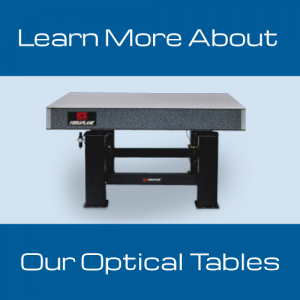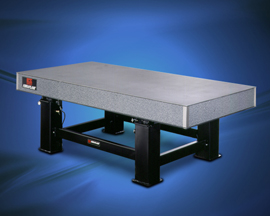Optical Table Selection Criteria
Better built through better design to provide you with performance matched to your application
Whichever model you choose, our tables at Kinetic Systems are manufactured with the same precision tooling, and  high-quality materials. The tables differ only in the amount of internal damping. We use a modern aerospace epoxy laminated steel-and-honeycomb structural sandwich beam design concept adapted to produce highly rigid optical tables and breadboards. The high stiffness and structurally efficient light weight of the honeycomb design makes it ideal for optical tables, resulting in a significantly high natural frequency (and therefore less vibration) than possible with the same size solid granite or ribbed cast iron designs. All our standard honeycomb optical tables have ferromagnetic stainless steel top skins; carbon steel bottom skins and sides; a high shear modulus, corrosion-resisting, plated steel, hexagon cell honeycomb core; and a proprietary damped epoxy formulation. We manufacture our own precision honeycomb core. For added stiffness and damping, we add steel C-channels treated with a damped laminate to form the side and end panels of each table.
high-quality materials. The tables differ only in the amount of internal damping. We use a modern aerospace epoxy laminated steel-and-honeycomb structural sandwich beam design concept adapted to produce highly rigid optical tables and breadboards. The high stiffness and structurally efficient light weight of the honeycomb design makes it ideal for optical tables, resulting in a significantly high natural frequency (and therefore less vibration) than possible with the same size solid granite or ribbed cast iron designs. All our standard honeycomb optical tables have ferromagnetic stainless steel top skins; carbon steel bottom skins and sides; a high shear modulus, corrosion-resisting, plated steel, hexagon cell honeycomb core; and a proprietary damped epoxy formulation. We manufacture our own precision honeycomb core. For added stiffness and damping, we add steel C-channels treated with a damped laminate to form the side and end panels of each table.

Epoxy-lamination is performed under pressure with the top skin against a precision master tool plate. When the epoxy cures, the precision flatness of the master tool plate is effectively “frozen” and transferred to the top skin, or working surface, of the honeycomb optical table or breadboard.
Each top skin can receive mounting holes over the entire tabletop on a grid pattern of 1″ or 25mm spacing. Prior to assembly, topskins are drilled and tapped using our custom designed CNC drilling machines. After all chips are removed, the top skin and SPILLPRUF core are completely cleaned using a high pressure, high temperature, neutral detergent spray thus assuring a chip-free tabletop.
Finally, the steel side and end panels are mechanically attached using a proprietary method to the top and bottom skins for increased strength. The top surface is lightly sanded to provide a smooth, non-reflective finish and the sides are laminated with a scratch resistant, high pressure, granite-look laminate trim. The bottom surface is treated with a scratch-resistant, non-reflective black polyurethane finish. Before shipment, tables are checked for dynamic compliance, natural frequency, damping, and flatness.
Performance Specifications
| For Typical 4’ x 8’ x 12″ Table | |||||
| 5300 | 5200 | 5100T | 5100H | 5100 | |
| Flatness (overall) | ± 0.005″ | ± 0.005″ | ± 0.005″ | ± 0.005″ | ± 0.005″ |
| Damped natural frequency | 220 Hz | 230 Hz | 245 Hz | 270 Hz | 250 Hz |
| First resonance transmissibility Q | 2 to 6 | 6 to 9 | 9 to 13 | 13 to 18 | 15 to 20 |
| Deflection
under 250 lb concentrated load at center |
£ 7.0 (10) -5in. | £ 7.0 (10) -5in. | £ 7.0 (10) -5 in. | £ 7.0 (10) -5 in. | £ 9.5 (10) -5 in. |
| First resonance corner compliance | 1.8 m in/lb | 5 m in/lb | 8 m in/lb | 25 m in/lb | 25 m in/lb |
| Max. dynamic deflection coefficient | £ 0.3 (10) -3in. | £ 0.5 (10) -3in. | £ 0.6 (10) -3 in. | £ 0.7 (10) -3 in. | £ 0.9 (10) -3 in. |
| Max. isolated relative motion* | £ 0.8 (10) -9in. | £ 1.3 (10) -9in. | £ 1.5 (10) -9 in. | £ 1.9 (10) -9 in. | £ 2.4 (10) -9 in. |
| Core shear modules | 225,000 psi | 225,000 psi | 225,000 psi | 225,000 psi | 225,000 psi |
| *Performance with isolation under a light traffic random floor vibration condition of W Q =10 -10 g 2 /Hz | |||||
FEATURES
All KSI Tables Feature:
- SPILLPRUF™ Spill Management System
- High-Efficiency Broadband Damping
- Plated Steel Precision formed Honeycomb Core
- Low Reflective Surfaces
| 5300 | 5200 | 5100T | 5100H | 5100 | |
| Quad-Tuned Damping | YES | NO | NO | NO | NO |
| Tuned Damping | YES | YES | YES | NO | NO |
| Broadband Damping | YES | YES | YES | YES | YES |
| Ferromagnetic Stainless Steel Top Skin | 3/16″ Thick | 3/16″ Thick | 3/16″ Thick | 3/16″ Thick | 1/8″ Thick |
| Carbon Steel Bottom Skin, Black Polyurethane Finish | 3/16″ Thick | 3/16″ Thick | 3/16″ Thick | 3/16″ Thick | 1/8″ Thick |
| Plated Steel, Precision Formed Honeycomb Core | YES | YES | YES | YES | YES |
| Maximum Length* | 20’ | 20’ | 20’ | 20’ | 12’ |
| Maximum Width | 6’ | 6’ | 6’ | 6’ | 4’ |
| Maximum Thickness | 36″ | 36″ | 36″ | 36″ | 12″ |
| *Tables longer than 16’ are custom. | |||||
KSI Optical Table Damping Options
Quad-Tuned Damping
Our Ultimate Performance 5300 Series tables use “quad-tuned” damping in addition to the broadband damping of the epoxy. This method utilizes individually tuned absorbers embedded in all four corners of the table, tuned to the lowest two natural frequencies (bending and torsion) of each optical table. This is narrow band selective damping, provided by four frequency-tuned, mass-spring resonators dry-damped and tuned to resonant response, 180° out of phase, with the lowest natural mode frequency of the table. The out-of-phase inertial forces induced in each resonator mass acts to cancel or “absorb” the motion of the table at its natural frequency. 2“These tuned absorbers provide uniform damping performance over a broad temperature range. Competitive damping using “lossy” materials is temperature sensitive and can vary widely, particularly at lower than normal temperatures.”Tuned Damping
Our Superior Performance 5200 and 5100T Series tables feature the same construction as our 5300 Series tables except they use tuned absorbers embedded in the table. Further damping is provided by the energy-dissipating properties of our proprietary epoxy used in the table construction.
Broadband Damping
Our two economy models, the 5100H and the 5100 Series, are simply damped by the energy dissipating properties of our proprietary epoxy formulation used in the table construction. The energy dissipation is achieved by a thick coating of epoxy covering 100% of the inside surfaces of the top and bottom skins of the table. This is referred to as “free layer” or “broadband” damping and is particularly effective at all high frequency resonances of the table.
The tables’ dynamic compliance, modal frequencies, and damping properties are obtained with state-of-the-art instrumented impulse force hammers, accelerometers, and an FFT (Fast Fourier Transform) program in a portable computer for storage and graphical presentation. 3

Flatness is measured with an electronic level with a resolution of ±1 arcsec or 4.8 microinches per inch. Flatness readings are computer-recorded along 8 lines comprising the perimeter of outside holes, principle diagonals and centerlines of the table, and then graphed in “Union Jack” format. Standard flatness for all tables is ±0.005 in. (±0.13mm) in the measured perimeter. Breadboard flatness is ±0.004 in. (±0.1mm) per 24 in. (610mm.)
For Special Requirements
Ask our applications engineers about the numerous available skin and core material options, including aluminum, nonmagnetic stainless steel and Invar. All KSI Optical Tabletops can be customized for length and width and can include special shapes, cutouts, and notches.
For more technical information, see Isolation Basics, Optical Tables 101, and VIBRAPLANE sections.
You can also contact us and our team of engineers will work with you to come up with the best solution to fit your needs.

2 DEN HARTOG, J.P. “Mechanical Vibrations,” Chapter 3, McGraw-Hill Book Co., 1956
3 HALVERSEN,W.G. and D.L. Brown, “Impulse Technique for Structural Frequency Response Testing”, Sound and Vibration, November, 1977

